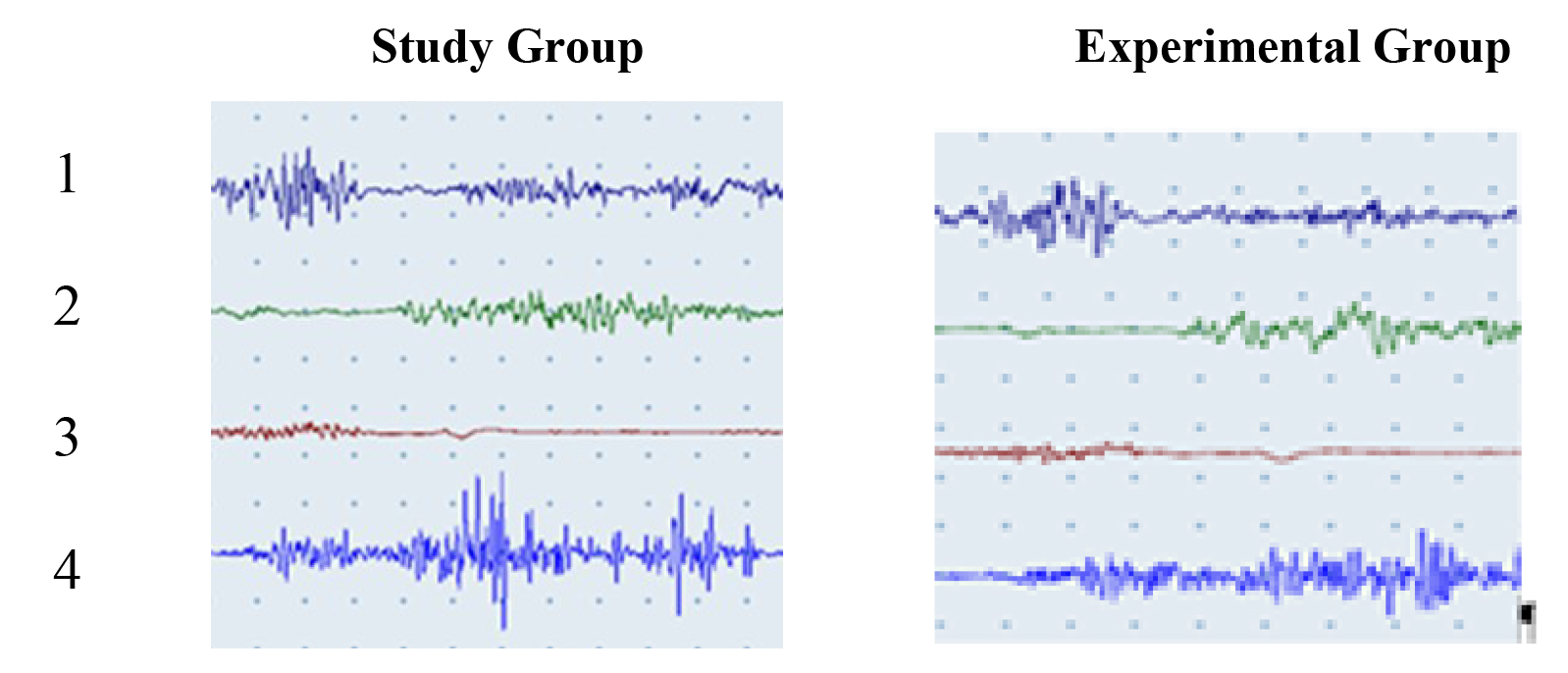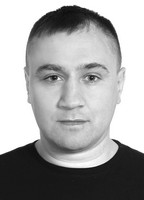Influence of muscle tension type on bioelectrical activity and regional blood flow in lower limbs of skilled boxers
Фотографии:
ˑ:
S.N. Neupokoev1
PhD, Associate Professor J.P. Bredikhina2
PhD, Associate Professor N.L. Guseva1
1National Research Tomsk State University, Tomsk
2National Research Tomsk Polytechnic University, Tomsk
Keywords: boxing, bioelectrical activity of muscles, regional blood flow, ballistic type of punches, training process.
Introduction. Explosive ballistic type of muscle tension is characteristic of maximum force punches in athletes of the game like bout manner [2]. Ballistic movement is a movement in which the muscles involved are active only at the beginning of the movement, while the antagonist muscles are relaxed and not involved in the work [5, 7]. At the same time, the conducted research indicates that punch-excelling practices by means of special preparatory exercises using heavyweight boxing equipment adversely affects their motor-coordination characteristics [1, 3]. Therefore, it is relevant to find the ways to protect hands from injury in the training process in order to eliminate pain and its impact on the biomechanical criteria of the punches performance [4, 6].
Objective of the study was to assess the influence of various types of muscle tension on bioelectrical activity and regional blood flow in the lower limbs of skilled boxers.
Methods and structure of the study. Two equivalent groups were involved in the experiment: Experimental Group (EG) and Reference Group (RG), consisting of 20 19-23-year-old boxers each, all qualified Candidate Masters of Sport (CMS). The methods applied included electromyography and rheography.
Results and discussion. The analysis of the electromyogram recording of the last in a series straight blow performed by the CMS boxers (Fig. 1) revealed that in the EG the right shin muscle and left thigh extensor muscle got involved in the work earlier than in the RG. The left shin muscle contraction reached its maximum rate first in the EG, then in the RG; besides in the EG it was more intense than in the RG (Fig. 1).

Fig. 1. Electromyogram indices of the lower limb muscles involved in the single punch movement excelling process in skilled boxers.
Legend: 1 – right shin muscle, 2 – right shin extensor muscle, 3 – left shin extensor muscle, 4 – left shin muscles
When analyzing the numerical results of the electromyographic study, we found that the maximum amplitude of electrical activity of the right shin muscle in the EG was higher by 180.4% compared to the RG (p˂0.05). The mean amplitude of the right shin muscle in the EG was higher by 63.2% than in the RG, and the oscillation frequency was higher by 368.1% (p<0.05). This fact suggests that limiting the traumatic impact on the hand interacting with a heavy boxing bag by means of boxing gloves (10 oz) contributes to the optimal motor activity of the muscles involved in the stroke. The movement begins by means of intensive work of the right shin muscle in the form of powerful pushing away (1st phase). The maximum peak of bioelectrical activity of motor units (MU) involved in the synchronous work during the motor action performance was more pronounced in the athletes of the EG rather than the RG.
The maximum amplitude values of the right thigh extensor muscle in the EG were higher by 75.5% than those in the RG (p<0.05), while the mean amplitude values - by 48.6% (p<0.05), and the oscillation frequency - by 75.4% (p˂0.05). This suggests that in the athletes of the SG the right thigh is involved in the work because of the momentum given by the shin muscle that transmits an additional impulse for development of a more significant peak of the bioelectrical activity of the muscles when punching.
When monitoring the bioelectrical activity of the left leg muscles performing the supporting function in the final phase of the punch movement, we noted that the values of the maximum amplitude of the left thigh extensor muscle in the EG athletes were higher by 30.8% than those in the RG (p<0.05). The mean amplitude of electrical activity in the EG was higher by 26.3% than in the RG (p˂0.05). At the same time, the oscillation frequency in the EG was lower by 52.3% than in the RG (p˂0.05). This fact suggests that in the SG the synchronism of the MU when performing the movement is achieved in a shorter space of time, while the number of MU involved in the work is significantly lower as compared to the results obtained in the RG. We assume this is due to lower support on the front leg, being less significant for athletes performing punches by means of ballistic type of muscle tension. This type of punch implies optimal transferring of the body weight to the front leg towards a stroke. The EG athletes using the standard sports outfit, due to the traumatic impact on the hand, transfer their body weight to the front leg more pronouncedly and weight it down even more to make the movement maximally rigid by involving the upper limbs, which is typical of non-ballistic type of punches.
When assessing the bioelectrical activity of the left shin muscle, we found that the maximum amplitude of electrical activity in the EG was lower by 35% compared with the RG (p<0.05). The mean amplitude values were insignificantly different (p> 0.05), and the oscillation frequency in the EG was lower by 24.4% compared with the RG (p<0.05). This fact suggests that it is reasonable for the EG athletes to transfer their body weight to the front leg and lean less on the front plantaris, as opposed to the RG boxers, who perform punches by means of non-ballistic type of muscle tension.
When examining the blood flow in the right thigh of the CMS athletes, the following values were obtained: the post-exercise rheographic index (RI) values in the EG were higher by 67.6% than the RG (p<0.05). The values of the amplitude-frequency indicator (AFI) in the EG athletes were higher by 90.4% than in the RG (p˂0.05). The maximum rapid filling velocity (Vmax) after exercise in the EG athletes was higher by 43.4% than that in the RG (p˂0.05). The rheographic study of the left thigh found that the RI values in the EG were higher by 116.7% than in the RG (p˂0.05). The AFI values recorded in the SG after exercise were higher by 48.8% than in the RG (p˂0.05). The average slow filling velocity (Vav) rate in the EG was higher 23.1% than in the RG, and the venous outflow coefficient (VOC) in the SG was higher by 21.7% than that in the RG (p<0.05). The RI values of the right shin of the CMS boxers of the EG were higher by 27.3% than in the RG (p˂0.05). The AFI values registered after exercise in the EG prevailed those in the RG by 54.9% (p˂0.05). The Vav values recorded after exercise also prevailed in the EG - by 42.9% (p˂0.05).
When summarizing the test results of the regional blood flow in the left shin of the CMS athletes, the following values were obtained: the RI values registered in the EG after exercise were lower by 22.4% than in the RG (p˂0.05). The amplitude-frequency indicator in the EG was lower by 38.1% than in the RG (p˂0.05). Vmax after testing was lower by 22.9% than in the RG (p˂0.05).
Conclusions. The use of sport outfit that limits the traumatic impact on the hands (boxing gloves) during the training process enables skilled athletes to perform movements in line with the optimal motor-coordination parameters, without any detectable effects of distractive factors. Performance of punches of the explosive ballistic muscle tension type contributes to more significant involvement of the lower limb muscles and improves blood filling and venous outflow in these muscles. At the same time, performance of punches using the standard sport outfit prevents from preserving the best biomechanical characteristics of movement, which adversely affect the athletic training process of boxers.
References
- Lukyanenko V.P., Khezhev A.A., Bazhev A.Z. Spetsializirovannaya silovaya podgotovka, kak uslovie povysheniya tochnosti dvizheniy i sovershenstvovaniya tekhnicheskogo masterstva [Special strength training to improve movement accuracy and technical skills]. Teoriya i praktika fiz. kultury, 2015, no. 8, pp. 15–19.
- Tishchenko A.V. Parametry stiley vedeniya bokserskikh poedinkov i ikh vzaimosvyaz s pokazatelyami effektivnosti boevykh deystviy [Parameters of fighting styles in boxing and their interrelation with indicators of efficiency of military operations]. Omskiy nauchny vestnik, 2011, no. 4 (99), pp. 179–182.
- Filimonov V.I. Sovremennaya sistema podgotovki bokserov [Modern training system in boxing]. Moscow: INSAN publ., 2009, 480 p.
- Arai K., Toh S., Nakahara K. Treatment of soft tissue injuries to the dorsum of the metacarpophalangean joint (Boxer's knuckle). J. Hand Surg., 2002, vol. 27, no. 1. pp. 90–95.
- Illarionova, A.V., Kapilevich, L.V. Distinctive features of intramuscular and intermuscular coordination at power graduation in the context of balance training. Teoriya i praktika fiz. Kultury, 2014, no. 12, P.44-46.
- Kapilevich L.V., Guzhov F.A., Bredikhina Yu.P., Il'in A.A. Physiological mechanisms to ensure accuracy and coordination of movements under conditions of unstable equilibrium and moving target (the case of strikes in sports karate). Teoriya i praktika fiz. Kultury, 2014, no. 12, pp. 22-24.
- Walilko T.J., Viano D.S., Bir C.A. Biomechanics of the head for Olympic boxer punches to the face. Br. J. Sports Med., 2005, vol. 39, pp. 710–719.
Corresponding author: kapil@yandex.ru


